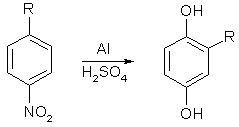Toluquinone and ToluhydroquinoneToluquinonep-Toluquinone from o-Toluidine [1] A solution of 20g of o-Toluidine in a mixture of water (600 ml) and concentrated sulfuric acid (160g, 80ml) is placed in a stout beaker immersed in ice-cold water and continous stirring is begun. During the course of an hour 20g of finely powdered potassium dichromate are added in portions of about 1g at a time, care being taken that the temperature does not rise above 10°C. An even better method is to add a solution of 20g of sodium dichromate in 100 ml of water from a dropping funnel. In either case the mixture is left in a cool spot overnight, and then a further quantity of potassium dichromate (33g), or a solution of sodium dichromate (40g in 200 ml of water), added under conditions similar to the above. After four or five hours the mass is extracted three times with ether, the ethereal solution dried with calcium chloride, and the ether removed by evaporation. The crude quinone is purified by distillation in steam, or by sublimation, and forms orange-yellow needles with a characteristic pungent odour. Melting-point, 67°C. Yield, 19g (82% of theory). ToluhydroquinoneToluhydroquinone [2]  4-alkylnitrobenzenes are reduced with powdered Aluminum and aqueous acid (H2SO4, H3PO4, HCl, (CO2H)2, or RSO3H) to the corresponding alkyl hydroquinones; the alkyl chain may be up to 4 C atoms in lenght. Reduction at elevated temp. yields the corresponding alkyl p-aminophenols obtained in mixt. with the hydroquinones. Addition of 7.5g Al flakes [Osmium bets turnings or his favorite sheet will work] over 1.5-2.0 hrs. at 95° to 17.5g p-nitrotoluene in 37.5 ml. conc H2SO4 (d. 1.85) and 500ml. H2O, filtration, and steam distillation gave a little (p-MeC6H4)2NH, mp 78-79°; extraction with Et2O gave 4.5g toluhydroquinone, mp. 125°C (from petroleum ether); addition of Na2SO3 and Na2CO3 until the soln was alkaline, filtration, treatment with Et2O and EtOH and concentration of the organic extracts gave 0.65g p-toluidine, m. 44°C. A similar reaction with a smaller amount of Al gave some p-cresol in addn. to the above products. p-O2N-C6H4-Et similarly gave ethylhydroquinone. Similarly, p-PrC6H4-NO2 yields propylhydroquinone, m. 89-90C°C. p-BuC6H4-NO2 similarly yields butylhydroquinone, m. 86.5-87.0°C The Al flakes may be conveniently added to a mixture of the alkylnitrobenzene and aqueous acid. Toluhydroquinone (Method 1) [3] Dissolve or suspend 10 grams of p-toluquinone in 2M HCl, and add a little Zinc powder. When the solution is colorless, filter, neutralize with NaHCO3, extract the dihydric phenol with ether, and evaporate the solvent. Toluhydroquinone (Method 2) [3] Dissolve or suspend 10 grams of p-toluquinone in 100ml of ether and shake vigorously with a solution of 20 grams of sodium hydrosulfite (Na2S2O4) in 200 ml of 1 M sodium hydroxide solution until the color of the quinone has disappeared. Separate the alkaline solution of toluhydroquinone, cool it in ice, and acidify with concentrated HCl. Collect the product (with Et2O extraction or filtration?) and recrystallize from water or alcohol. References [1] Sudborough & Campbell, Practical Organic Chemistry
|